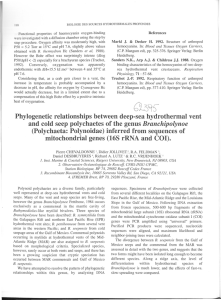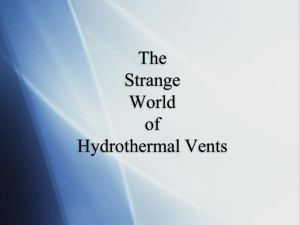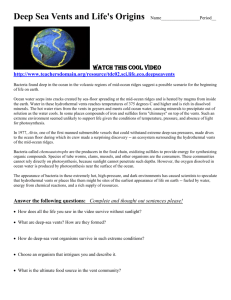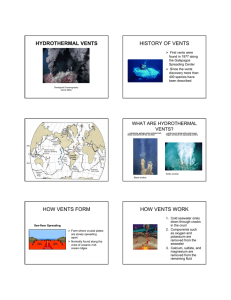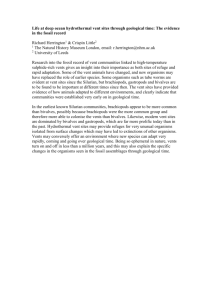Document 13309919
advertisement
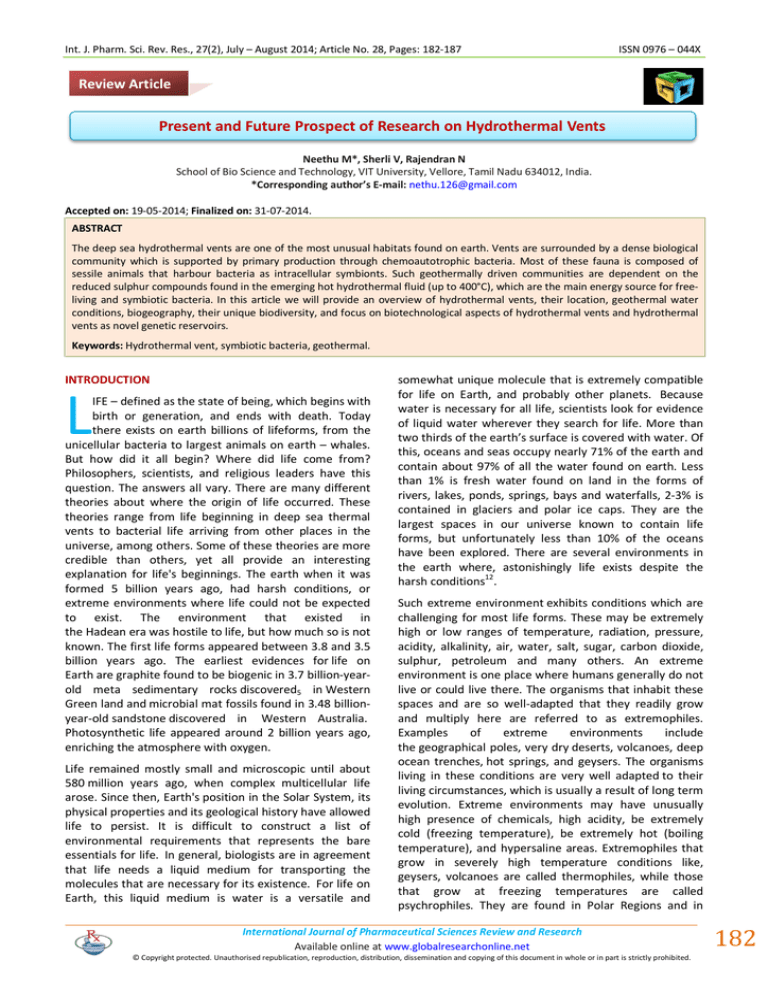
Int. J. Pharm. Sci. Rev. Res., 27(2), July – August 2014; Article No. 28, Pages: 182-187 ISSN 0976 – 044X Review Article Present and Future Prospect of Research on Hydrothermal Vents Neethu M*, Sherli V, Rajendran N School of Bio Science and Technology, VIT University, Vellore, Tamil Nadu 634012, India. *Corresponding author’s E-mail: nethu.126@gmail.com Accepted on: 19-05-2014; Finalized on: 31-07-2014. ABSTRACT The deep sea hydrothermal vents are one of the most unusual habitats found on earth. Vents are surrounded by a dense biological community which is supported by primary production through chemoautotrophic bacteria. Most of these fauna is composed of sessile animals that harbour bacteria as intracellular symbionts. Such geothermally driven communities are dependent on the reduced sulphur compounds found in the emerging hot hydrothermal fluid (up to 400°C), which are the main energy source for freeliving and symbiotic bacteria. In this article we will provide an overview of hydrothermal vents, their location, geothermal water conditions, biogeography, their unique biodiversity, and focus on biotechnological aspects of hydrothermal vents and hydrothermal vents as novel genetic reservoirs. Keywords: Hydrothermal vent, symbiotic bacteria, geothermal. INTRODUCTION L IFE – defined as the state of being, which begins with birth or generation, and ends with death. Today there exists on earth billions of lifeforms, from the unicellular bacteria to largest animals on earth – whales. But how did it all begin? Where did life come from? Philosophers, scientists, and religious leaders have this question. The answers all vary. There are many different theories about where the origin of life occurred. These theories range from life beginning in deep sea thermal vents to bacterial life arriving from other places in the universe, among others. Some of these theories are more credible than others, yet all provide an interesting explanation for life's beginnings. The earth when it was formed 5 billion years ago, had harsh conditions, or extreme environments where life could not be expected to exist. The environment that existed in the Hadean era was hostile to life, but how much so is not known. The first life forms appeared between 3.8 and 3.5 billion years ago. The earliest evidences for life on Earth are graphite found to be biogenic in 3.7 billion-yearold meta sedimentary rocks discovered5 in Western Green land and microbial mat fossils found in 3.48 billionyear-old sandstone discovered in Western Australia. Photosynthetic life appeared around 2 billion years ago, enriching the atmosphere with oxygen. Life remained mostly small and microscopic until about 580 million years ago, when complex multicellular life arose. Since then, Earth's position in the Solar System, its physical properties and its geological history have allowed life to persist. It is difficult to construct a list of environmental requirements that represents the bare essentials for life. In general, biologists are in agreement that life needs a liquid medium for transporting the molecules that are necessary for its existence. For life on Earth, this liquid medium is water is a versatile and somewhat unique molecule that is extremely compatible for life on Earth, and probably other planets. Because water is necessary for all life, scientists look for evidence of liquid water wherever they search for life. More than two thirds of the earth’s surface is covered with water. Of this, oceans and seas occupy nearly 71% of the earth and contain about 97% of all the water found on earth. Less than 1% is fresh water found on land in the forms of rivers, lakes, ponds, springs, bays and waterfalls, 2-3% is contained in glaciers and polar ice caps. They are the largest spaces in our universe known to contain life forms, but unfortunately less than 10% of the oceans have been explored. There are several environments in the earth where, astonishingly life exists despite the harsh conditions12. Such extreme environment exhibits conditions which are challenging for most life forms. These may be extremely high or low ranges of temperature, radiation, pressure, acidity, alkalinity, air, water, salt, sugar, carbon dioxide, sulphur, petroleum and many others. An extreme environment is one place where humans generally do not live or could live there. The organisms that inhabit these spaces and are so well-adapted that they readily grow and multiply here are referred to as extremophiles. Examples of extreme environments include the geographical poles, very dry deserts, volcanoes, deep ocean trenches, hot springs, and geysers. The organisms living in these conditions are very well adapted to their living circumstances, which is usually a result of long term evolution. Extreme environments may have unusually high presence of chemicals, high acidity, be extremely cold (freezing temperature), be extremely hot (boiling temperature), and hypersaline areas. Extremophiles that grow in severely high temperature conditions like, geysers, volcanoes are called thermophiles, while those that grow at freezing temperatures are called psychrophiles. They are found in Polar Regions and in International Journal of Pharmaceutical Sciences Review and Research Available online at www.globalresearchonline.net © Copyright protected. Unauthorised republication, reproduction, distribution, dissemination and copying of this document in whole or in part is strictly prohibited. 182 Int. J. Pharm. Sci. Rev. Res., 27(2), July – August 2014; Article No. 28, Pages: 182-187 ISSN 0976 – 044X deep sea. Those found in thermal vents, hot springs and other acidic environments are acidophiles, alkaliphiles are found in soda lakes in Africa and halophiles in salt lakes. precious metals such as silver, gold, and platinum, as well as those often thought of as highly toxic to life (e.g., cadmium, mercury, arsenic and lead). Deep sea hydrothermal vent Location The deep sea hydrothermal vents are one of the most unusual habitats found on earth. A hydrothermal vent is a fissure in the planet’s surface from which geothermally heated water issues. The hydrothermal environment is harsh, considering the pressure (260 atmospheres), temperature (226°F) and toxicity of the hydrothermal fluid which is acid, anoxic, and rich in metallic sulphides. One current theory is that life originated deep beneath the surface of the ocean at deep sea hydrothermal vents. These vents release hot gaseous substances from the centre of the earth at temperatures o in excess of 572 F. Previously scientists were sure that life could not exist, deep beneath the surface of the ocean. After the discovery of hydrothermal vents, they found ecosystems thriving in the depths of the ocean. These ecosystems contained various types of fish, worms, crabs, bacteria and other organisms which had found a way to survive in a cold, hostile environment without energy input from sunlight. Because life had been found to exist where it previously was thought unable to, many scientists began to ask questions as to whether or not this was where life may have originated on the earth. Hydrothermal vents are commonly found near volcanically active places, in areas where tectonic plates are moving apart, in ocean basins, and hotspots. Hydrothermal vents exist because the earth is both geologically active and has large amounts of water on its surface and within its crust. First discovered in 1977 at a spreading ridge in the Pacific Ocean near the Galapagos Islands, hydrothermal venting has now been detected along all open-ocean spreading centres called mid-ocean ridges. Since 1977, scientists have discovered some 100 vent sites around the globe. Many have interesting names. A site near the “Garden of Eden” on the Galápagos Rift was named “East of Eden”. In the Atlantic, the seafloor topography near the “Broken Spur” site has a series of “spurs” coming off the ridge. The “Lucky Strike” the name of a field of hydrothermally active vents, situated southwest of the Azores in Portuguese waters on the Mid Atlantic Ridge (37°18´N,32°16´W) ,vent site was found by chance when scientists were dredging up samples of seafloor rocks. The Snake Pit Hydrothermal Site lies on the axis of the Mid-Atlantic Ridge at 23°22′ N latitude, about 30 km south of the Kane Transform Intersection- was named after the slithering mass of white, eel-like fish that scientists found living there12. Biologists have participated in a series of submersible dive to 130 N & 21ON on the East Pacific Rise - off Mexico ,the Guaymas Basin at 270 N on the East Pacfic Rise in the Gulf of California, and to an axial seamount on the Juan de Fuca Ridge at 46o N , and found presence of the numerous vents. In 1977, a remotely operated still- camera sled was photographing the floor of the mid- ocean ridge and registered a highly unusual temperature spike in the freezing ocean floor. Initially thought to be an anomaly, scientists were stunned to discover the vents. The chemosynthetic ecosystem surrounding submarine hydrothermal vents were discovered along the Galapagos Rift, a spur of the East Pacific Rise, by a group of marine geologists led by Jack Corliss of Oregon State University. In 1979, biologists returned to the rift and used DSV Alvin, an ONR research submersible from Woods Hole Oceanographic Institute, to see the hydrothermal vent communities with their own eyes. In that same year, Peter Lonsdale published the first scientific paper on hydrothermal vent life. Over the past 30 years many more hydrothermal vents were discovered. In the deep ocean these vents are most often found along mid-ocean ridges, where the plates of the Earth’s crust are being slowly pulled apart and molten lava from below forms new crust. Geothermal water and conditions The vent fluid is geothermally heated close to the magma chamber that feeds the ridge, reaching temperatures that can exceed 254°F. The fluid is also chemically modified, losing all dissolved oxygen and accumulating high concentrations of dissolved reduced gases such as methane and hydrogen sulphide. They are also strongly acidic (pH 2–3) compared to the near-neutral character (~ pH 8) of the deep oceans and are rich in numerous metals dominantly iron, manganese, copper, and zinc, but also In 2000, Japanese scientists discovered the first vent site in the Indian Ocean and named it after their research vessel “Kairei”. Several months later, a U.S. expedition found another Indian Ocean vent site and named it “Edmond,” in memory of John Edmond- a pioneer and leader of hydrothermal vent research. So far, most vents have been found on volcanically active mid-ocean ridges with newly made seafloor crust. But that may be only because scientists have focused their search for vents on ridges. In December 2000, on an expedition led by Donna Blackman of Scripps Institution of Oceanography and Jeff Karson of Duke University, scientists in Alvin were surprised to find a vent field in the Atlantic Ocean that was tens of miles away from a ridge, on million-year-old seafloor crust. It had skyscraper-like structures, many stories high that were made of white carbonate material, not dark sulfide minerals. They called this unique vent site 14 “Lost City” . Food web The vent food chain appears to be short, although there 10 are probably many hidden complexities . Autotrophic bacteria live in the subsurface plumbing system of vents, International Journal of Pharmaceutical Sciences Review and Research Available online at www.globalresearchonline.net © Copyright protected. Unauthorised republication, reproduction, distribution, dissemination and copying of this document in whole or in part is strictly prohibited. 183 Int. J. Pharm. Sci. Rev. Res., 27(2), July – August 2014; Article No. 28, Pages: 182-187 these autotrophic bacteria are the primary producers. The primary consumers are the hosts to endosymbiotic bacteria; for example the tubeworms; the grazers, such as the limpets; and the suspension-feeders, which include the serpulid worms. Most species which host endosymbionts depend for sustenance entirely on the internal bacteria. The secondary consumers include the scavengers and carnivores. This group includes the crabs, fishes, and many of the worms and shrimp. It is difficult to rigidly classify the secondary consumers because their feeding preferences tend to be broad. For instance, a scavenger of miscellaneous organic detritus may also graze on bacteria; another may eat a smaller animal. There are probably few pure carnivores; the whelk may be one. Parasites are also part of the food web. Studies using stable isotope ratios of carbon or nitrogen have helped to show general eating patterns, particularly the link between bacteria and primary consumers. Vent communities At hydrothermal vent sites, hot mineral rich water spews from the sea floor, and mixes with cold oceanic water. Hydrothermal vents show much higher productivity but much lower species diversity. Vent chemistry provides the energy and raw materials with which microorganisms grow. These microorganisms form the basis of the food chain in which unexpectedly high organism densities and growth rates are observed. Individual vent sites are extremely ephemeral on geological time scales, lasting only on the order of years to decades20. Volcanic eruptions can destroy whole communities, or vent fluids can cease to flow, slowly chilling and starving dependent communities. As vents wane, organism associations can be observed to be slowly transitioning as they gain greater similarity to background communities21. Hydrothermal vents occur at ocean spreading centers, that is, at locations where tectonic plates are pulling apart, creating new ocean floor as volcanic material rises to fill in the space between the plates. Vent fields can be thought of as being divided into three zones: the vent opening, the near-field, and the periphery. Most of the vent biomass is at the vent openings, where most of the animals are crowded together. As the heated vent effluent rises, it entrains and mixes with the bottom water that is at the ambient deepsea temperature of 32.5-33.1°F. The result is a local circulation pattern of cold water converging on the vent openings. Only very near the vent opening the water have sufficient sulphide or other reduced ions to support 5 symbiosis with oxidizing bacteria . Biodiversity Unique communities are formed around vents, attracting unusual creatures such as red-plumed giant tube worms and massive clams, which cluster around the dark chimneys where vent fluids emerge. Within individual communities, the distributions of organisms are affected ISSN 0976 – 044X by the environmental gradient created by the mixing of vent fluids with ambient sea water. Microorganisms first moved in, filling the water near the vents and also forming microbial mats on nearby surfaces. These abundant microorganisms attracted mobile vent fauna such as amphipods, copepods, and crabs. It can be a chancy life for organisms living at hydrothermal vents18. Individuals of many of these species can grow to be quite large. Some vestimentiferans may be a meter long, and their tubes can be three times longer. Often living among these large animals there are a variety of smaller creatures, including limpets, polychaete worms, bresiliid shrimp, bythograeid crabs and bythitid fish. The gills of a tubeworm may be bathed in vent water high in sulphide and lacking in oxygen; but a moment later when the plume of effluent shifts direction, the animal is exposed to ambient bottom water that is rich in oxygen and devoid of sulphide. The vent periphery is populated by non-vent animals attracted to the vent for any nourishment it might offer. Peripheral animals may include enteropneustshe dandelion siphonophore, sea cucumbers, and large protozoans called Xenophyophoria. Most of the peripheral animals do not enter into the vent near field, although large spider crabs and rattail fish are known to do so22. The plume of vent effluent, with its load of bacteria, plankton and organic particles, may be a significant source of nutrition to the nearby non-vent community1. Factors associated with geographic location and the degree of isolation from other venting sites exerts a substantial influence on the organisms most likely to be found at a given hydrothermal vent. Biogeography More than 200 vent fields have been documented since the late 1970’s13. For vent species to survive over geologic time, the fauna must find or colonize new vents. Compared to other deep-sea communities, hydrothermal vents show much higher productivity but much lower species diversity23. There is no mistaking a healthy, thriving vent for a dead one, an area that may be littered with the empty shells of the jumbo clam Calyptogena, or tubeworms, once tall and robust, now blackened and prostrate. Factors affecting vent There are several factors that are responsible for making a vent die. Tectonic disruption, such as an earthquake or volcanic eruption, may interrupt the discharge of hydrothermal fluids; mineral precipitates inside chimneys may choke the flow of fluids; the heat or sulfide sources may be exhausted. The vent mussel, which has retained the ability to filter food from surface water- productivity, has been observed as the only survivor at otherwise dead 11 vents. But the mussel is the exception . Most vent species rely on their progeny for dispersal. In the same way that most plants depend on the dissemination of their seeds to sustain the continuation of their species, International Journal of Pharmaceutical Sciences Review and Research Available online at www.globalresearchonline.net © Copyright protected. Unauthorised republication, reproduction, distribution, dissemination and copying of this document in whole or in part is strictly prohibited. 184 Int. J. Pharm. Sci. Rev. Res., 27(2), July – August 2014; Article No. 28, Pages: 182-187 dispersal of most vent species depend on larvae which move through the water with the currents. The period of larval dispersal is a hazardous time for any marine species; it often means travelling over long distances of hostile terrain. Currently, no evidence suggests the existence of symbiotic relationships between animals and the chemoautotrophic microorganisms forming the bottom of the food chain. Instead it appears that the marine invertebrates gain energy from grazing on ventassociated carbonates and microbial biofilms. Many larvae are eaten before getting to where they need to be, and most never reach their destination, but drift away from an area suitable for habitation. The plentiful supply of nutrients at vents results in high fecundity for some animals, and for a lineage to perpetuate itself, only two of the progeny need survive to reproductive age. i) Dispersal Adapting to the hydrothermal fluid chemistry is only one challenge. For vent species to survive over geologic time, the fauna must find or colonize new vents. ii) Distribution The distribution of vent fields is strikingly discontinuous. Their boundaries are sharply defined amid the intervening terrain of the typical deep sea. While some vent fields are tens of meters apart, others are separated by hundreds of kilometers. Most vent species are not broadly distributed, presumably because of the limitations imposed by dispersal. The closer two vent fields are, the more likely they are to share the same species. As the distance between vents increases, the differences between the faunas increase1. Factors affecting the structure of vent communities Hydrothermal vent structures are characterized by different physical and chemical factors, including the minerals, temperatures, and flow levels of their plumes. Black smokers emit the hottest, darkest plumes, which are high in sulfur content and form chimneys up to 18 stories tall, or 55 meters (180 feet). The plumes of white smokers are lightly colored and rich in barium, calcium, and silicon. Compared to black smokers, white smokers usually emit cooler plumes and form smaller chimneys. Vents with even cooler, weaker flows are often called seeps. They appear to shimmer because of differences in water temperatures or bubble because of the presence of gases, like carbon dioxide. Vent field size - global comparisons of vent fields shows higher taxanomic species of limited distribution. Water depth - while some vent fields are tens of meters apart, others are separated by hundreds of kilometres Most vent species are not broadly distributed, presumably because of the limitations imposed by dispersal. The closer two vent fields are, the more likely they are to share the same species. As the distance between vents increases, the differences between the faunas increase. ISSN 0976 – 044X Disease and predation also affect the community's makeup. Other probable factors are geochemical, including a change in the concentration of sulphide in the effluent or a change in the rate of effluent flow. Research on hydrothermal vents The prospect of studying hydrothermal vents presents a number of challenges, as site locations are frequently remote and found at great depths, and obtaining samples can require considerable ingenuity and complicated 9 equipment . The study of hydrothermal vents provides clues to the origin, evolution, distribution, and future of life on earth and in the universe. The discovery in 1977 of these extreme, dark environments with teeming life revolutionized thinking about the origin of life and extraterrestrial life. Microbial archaea at vent sites are among the oldest forms of life on Earth, so studying vents helps scientists understand conditions when life formed on Earth, and may shed light on the origin of life itself. Some scientists believe that life originated at hydrothermal vents, and some think there used to be similar vents on Mars, when there was tectonic activity. Genomic studies suggest that some of the thermophilic microorganisms found at hydrothermal vents come from very ancient lineages, a number of scientists have suggested that the environment at vent sites might be similar to conditions on other planets. The chemosynthetic model may offer a glimpse of what conditions might be faced by life in extraterrestrial systems. Studies of succession and vent biogeography provide a basis of comparison to address how other aquatic and terrestrial communities found in isolated systems develop and are populated. On a more immediately practical side, vent microorganisms might offer useful natural products and new biotechnologies, such as high temperature tolerant enzymes. Genetic resources Genetic resources in the world’s oceans are of actual and potential interest for commercial uses. The ratio of potentially useful natural compounds is higher in marine than terrestrial organisms. There is a higher probability of commercial success with marine-sourced material. There are numerous patents based on marine genetic resources and products on the market. Only 1-2 percent of preclinical candidates become commercial products. Patenting can be used as a proxy of commercial interest. Most patents and products based on organisms from coastal areas or exclusively economic zones (EEZs). In general, it is often difficult to tell the exact geographical location where a specimen was collected. Very few patent documents contain exact coordinates, some have a more general description of collection location, such as a deep sea hydrothermal vent, the Mid-Ocean Ridge or the East Pacific Rise, which may or may not be beyond national jurisdiction. Hydrothermal vents contain micro-organisms (archaea and bacteria) that have adapted to extreme environments, and thus have properties of interest to biotechnology. Approximately 80 hydrothermal vent International Journal of Pharmaceutical Sciences Review and Research Available online at www.globalresearchonline.net © Copyright protected. Unauthorised republication, reproduction, distribution, dissemination and copying of this document in whole or in part is strictly prohibited. 185 Int. J. Pharm. Sci. Rev. Res., 27(2), July – August 2014; Article No. 28, Pages: 182-187 microorganisms have been identified, and approximately 50 of them have been associated with patents and applications. Some organisms had several patents associated with them (ex. Thermococcus litoralis associated with 50 patents and a product found in the vents) Thermococcus barophilus-US 20110045489 can be used for hydrogen production. Alcanivorax dieseloleiCM1904033 used for environmental remediation to degrade alkanes. Majority of the patents are from the vents within EEZs, although some come from beyond national jurisdiction. Biotechnological applications of hydrothermal vent system The rate of discovery of new natural products from marine invertebrates and microorganisms appeared to have peaked in the late 1990s and to be declining at the turn of the century. The diverse assemblages of microbial symbionts associated with these readily collectable organisms, many compounds from which are of putative or proven microbial origin. Thermococcus S 557 (cultured under N2, 79.2 °F) and methanogenic Methanococcus janaschii (cultured under H2, CO2, 79.2°F) produced isoprenyl glycerol ethers respectively. Deep-water collections can be made in a nonselective sense by dredging, trawling, and coring, which in turn damage a significant portion of nontargeted benthic communities and structures. Numerous biotechnology companies are actively involved in product development from thermophilic vent organisms. These biotechnological interests have focused mainly on the use of whole cells, for example, sulfate reducing bacteria in waste management processes, and also the development of new enzymes and exopolysaccharides to improve agriculture, biotechnology, cosmetics, pharmaceutics, and even bone healing10. Vibrio diabolicaus – polysaccharide used for bone repair and other medical purposes. Fuelzyme™ enzyme was developed on the basis of samples collected from a deep-sea hydrothermal vent, likely from the Mid-Atlantic Ridge. This enzyme, which is currently marketed by Verenium (USA), is used in ethanol production from corn. Vent polymerase is a thermostable enzyme sourced from a hydrothermal vent archaebacteria in Italy. It is marketed by New England Biolabs (USA) for use in DNA cloning, sequencing and amplification. Venuceane™, an enzyme showing antioxidant properties, based on the bacteria Thermus thermophilus collected in the Guaymas Basin, Gulf of California at 2000m of depth. The enzyme is marketed by the French company Sederma for use in cosmetics. CONCLUSION Hydrothermal vent communities can inhabit sulphide rich habitats because of evolution of detoxification mechanism that often involve microbial symbionts. Studies of succession and vent biogeography provide a basis of comparison to address how other aquatic and terrestrial communities found in isolated systems develop ISSN 0976 – 044X and are populated. On a more immediately practical side, vent microorganisms might offer useful natural products and new biotechnologies, such as high temperature 9 tolerant enzymes . Genomic studies suggest that some of the thermophilic microorganisms found at hydrothermal vents come from very ancient lineages2. Studies of vent invertebrates, such as Riftia pachyptila, also show interesting body chemistries that help these organisms adapt to the stresses of the environment24. The discovery of hydrothermal vent communities has expanded the knowledge of the diversity of life and our understanding of the range of conditions in which life on earth can thrive. The impact of the geography and geological setting of hydrothermal vents on their biota implies even further untapped biological diversity awaiting discovery from the vast unexplored volcanic regions at more remote locations, which are currently beyond the manageable cost and logistics of deep-sea vent explorations. Due to their location in the deep ocean floor, ROVs & AUVs are needed for sampling. ALVIN – an AUV costs about 30,000 U.S dollars for one haul. Thus, research in deep sea hydrothermal vents is economically and infrastructurally expensive. So far only developed countries like America are equipped, in terms of financial and infrastructural resources to explore the hydrothermal vents. The bio discovery within these environments appears still to be in its infancy, as the full extent of the biological diversity present has yet to be realized. However, if these constrains can be overcome the study of the novel organisms present in this unique environment may prove to be a biotechnological jackpot. Acknowledgements: The author is grateful to the scientists who have contributed to the material being reviewed in the paper, Dr. Rajendran N for his support and Vellore Institute of Technology for a place to study and a chance to grow. REFERENCES 1. Arquit (A.M), Geological and hydrothermal controls on the distribution of megafauna in ASHES vent field, Juan de Fuca Ridge, Journal of Geophysical Research, 95, 1990, 12947-12960. 2. Ballard (R.D), Grassle (J.F), Return to oases of the Deep, National Geographic, 156, 1979, 680-705. 3. Boetius (A.), Lost City Life, Science (Wash.), 307, 2005, 1420-1422. 4. Fisher (C.R), TaKai (K.), and Bris (N), Hydrothermal Vent Ecosystems, Journal of Oceanography Society, 20, 1. 5. Childress (J.J), Felbeck (H), and Somero (G.N), Symbiosis in the deep sea, Scientific American, 255, 1987, 114-120. 6. Childress (J.J.) and Fisher (C.R.), The biology of hydrothermal vent animals: physiology, biochemistry, and autotrophic symbioses, Oceanography and International Journal of Pharmaceutical Sciences Review and Research Available online at www.globalresearchonline.net © Copyright protected. Unauthorised republication, reproduction, distribution, dissemination and copying of this document in whole or in part is strictly prohibited. 186 Int. J. Pharm. Sci. Rev. Res., 27(2), July – August 2014; Article No. 28, Pages: 182-187 7. 8. ISSN 0976 – 044X Marine Biology, an Annual Review, 30, 1992, 337441. oceanic spreading centers., Deep-Sea Res., 24(9), 1977, 857-863. Devey (C.W), Fisher (C.R), and Scot (S.), Responsible science at hydrothermal vents, a quarterly journal of The Oceanography Society, 20, 1986. 17. Lutz (R. A.), Shank (T. M.), and Evans (R.), Life After Death in the Deep Sea., Am. Sci. 89, 2001, 422-431. Colaco (A), Dehairs (F), and Desbruyeres (D.), Nutritional relations of deep-sea hydrothermal fields at the Mid-Atlantic Ridge: a stable isotope approach, Deep-Sea Res. (Oceanogr. Res. Pap.), 49, 2002, 395412. 18. Metaxas (A.), Spatial and temporal patterns in larval supply at hydrothermal vents in sea., Nature, 411, 2001, 77-80. Deming (J. W.), Deep ocean environmental biotechnology, Curr. Opin. Biotechnol. 9, 1998, 283287. 19. Jones (M.B.), Azevedo (J.M.N), Neto (A.L), Costa (A.C), and Martins (A.M.F) (eds), A review of the distribution of hydrothermal vent communities along the northern Mid-Atlantic Ridge: dispersal vs. environmental controls Island, Ocean and Deep-Sea Biology. Hydrobiologia, 440, 2000, 201–216. 10. Grassle (J.F.), The ecology of deep-sea hydrothermal vent communities, Advances in Marine Biology, 23, 1986, 301-362. 20. Micheli (F.), Predation structures communities at deep-sea hydrothermal vents., Ecol. Monogr. 72, 2002, 365-382. 11. Jannasch (H. W.), Biocatalytic transformations of hydrothermal fluids, Philos. Trans. R.Soc. Lond. (A Math. Phys. Sci. ) 355, 1997, 475-486. 21. Tsurami (M.), and Tunnicliffe( V.), Characteristics of a hydrothermal vent assemblage on a volcanically active segment of Juan de Fuca Ridge, northeast Pacific. Can. J. Fish. Aquat. Sci. /J. Can. Sci. Halieut. Aquat. 58, 2001, 530-542. 9. 12. Karson (J.A.), Brown (J.R.), Geologic setting of the Snake Pit hydrothermal site: An active vent field on the Mid-Atlantic Ridge, Marine Geophysical Researches, 10(1-2), 1988/’89, 91-107. 13. Kelley (D. S.), From the Mantle to Microbes: The Lost City Hydrothermal Field, Oceanography 18, 2005, 3245. 14. Kelley (D. S.)., A Serpentinite-Hosted Ecosystem: The Lost City Hydrothermal Field., Science (Wash) 307, 2005, 1428-1434. 15. Little (C.T.S.), and Vrijenhoek (R.C.), Are Hydrothermal Vent Animals Living Fossils?, Trends in Ecology & Evolution, 18, 2003, 582-588. 22. Tunnicliffe (V.), and Jensen (R.G.), Distribution and behaviour of the spider crab Macroregonia macrochira Sakai (Brachyura) around the hydrothermal vents of the northeast Pacific, Canadian Journal of Zoology, 65, 1987, 2443-2449. 23. Van Dover (C.L.), The Ecology of Deep-Sea Hydrothermal Vents., Princeton University Press, 2000, 424. 24. Yancey (P.H.), Organic osmolytes as compatible, metabolic and counteracting cytoprotectantsin high osmolarity and other stresses. J. Exp. Biol. 208, 2005, 2819-2830. 16. Lonsdale (P.), Clustering of suspension-feeding macrobenthos near abyssal hydrothermal vents at Source of Support: Nil, Conflict of Interest: None. International Journal of Pharmaceutical Sciences Review and Research Available online at www.globalresearchonline.net © Copyright protected. Unauthorised republication, reproduction, distribution, dissemination and copying of this document in whole or in part is strictly prohibited. 187
